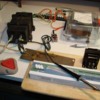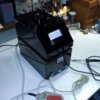Hi:
I believe I have finally perfected my switch technique to produce a very acceptable switch and it only took till switch #5. My first 4 were good, but finally I feel comfortable with the most difficult part, the frog.
The quality is determined by how quietly a metal wheel truck moves through the frog assembly. The key is to use an NMRA wheel and flange /track gauge. Also, work from the straight stock rail and make all radius modifications from there. Be sure the truck wheels are gauged as well.
Make your own simple frog alignment/soldering tool or jig. This helps with belt sanding the angles. Also, the rail can be pinned down to ensure flatness and stability by inserting pins thru short pieces of tie cut-off pieces while soldering.
The frog takes a lot of solder and after use a saber saw blade held by vice grips to obtain the correct flange depth.
Note that the Flange opening follows a straight line from the heel to the toe.
Note also a scrap piece of aluminum nailed where the frog is soldered to keep from burning up your jig.
Thanks for looking....







